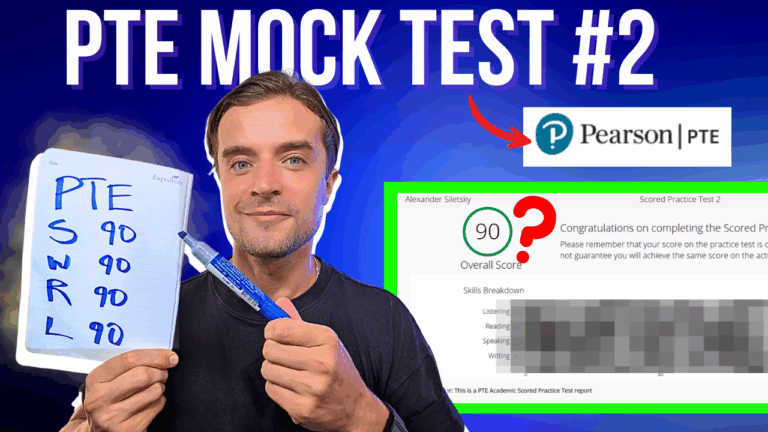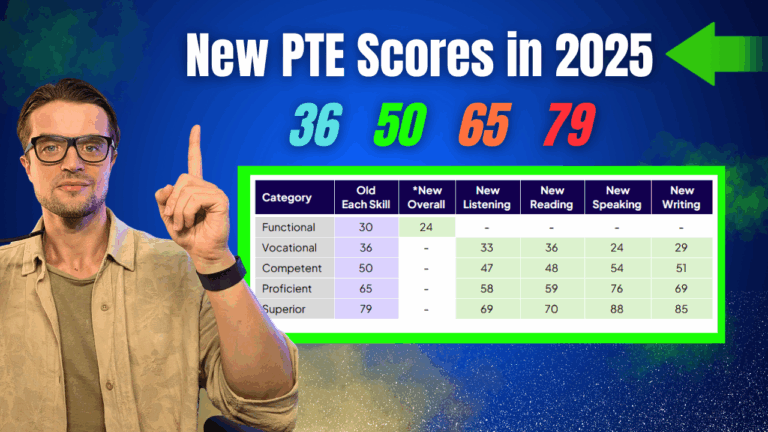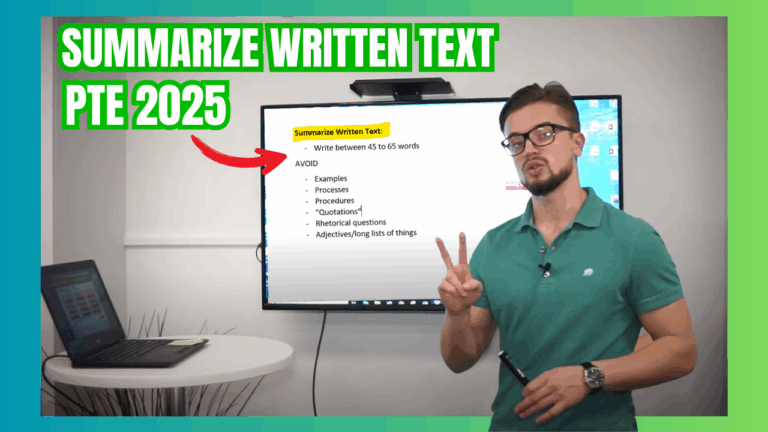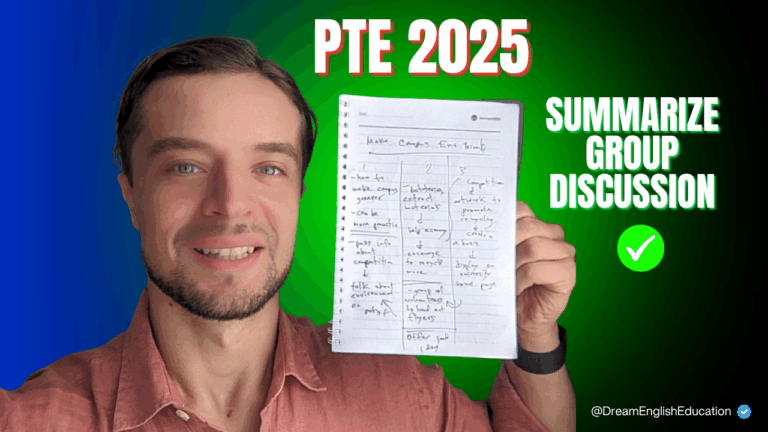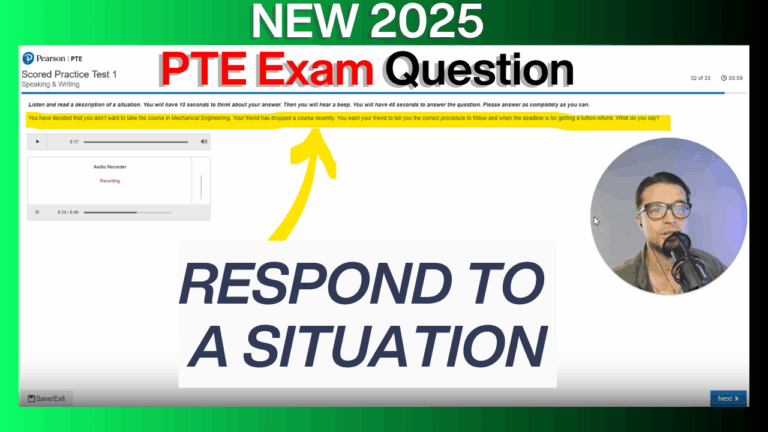PTE Read Aloud 2025 STRATEGIES: How to Score 90
PTE Read Aloud 2025 Strategies:
How to Score 90
PTE Read Aloud is your first opportunity to establish speaking excellence and set the tone for your entire exam performance, yet most students approach it with outdated strategies that cap their scores at 70-75. If you’re targeting how to score 90 in PTE Read Aloud and want to master the specific techniques that separate high achievers from average performers, you’re about to discover the exact methods I use when aiming for maximum scores.
In this post we’re going to reveal the PTE Read Aloud strategy that we just used during the Official PTE Practice Test – including techniques that most students have never heard of but which can instantly improve your pace control and accuracy.
Here’s what most PTE guides won’t tell you: PTE Read Aloud tips that focus only on pronunciation and fluency miss the most critical element – maintaining perfect synchronization between your reading and speaking throughout the entire passage. The students who consistently score 85+ have mastered techniques that go far beyond basic reading skills.
The PTE Read Aloud technique I’m about to share isn’t just theory – it’s the exact approach I used during my recent practice test when targeting 90+ scores. You’ll see how proper preparation, strategic pacing, and the finger following method can transform your Read Aloud performance from good to exceptional.

Understanding PTE Read Aloud Scoring in 2025
Before diving into advanced techniques, you need to understand how PTE Read Aloud scoring has changed and what the system actually evaluates when determining your score.
The 2025 Scoring Update: As we mentioned on this blog and our YouTube, “starting from the 7th of August, Read Aloud doesn’t give points in reading anymore.” This is a crucial change that affects how you should approach this task. Read Aloud now contributes only to your Speaking score, which means your strategy should focus entirely on oral fluency, pronunciation, and speaking rhythm rather than reading comprehension.
This change is actually liberating for students who understand its implications. You no longer need to worry about perfect reading accuracy affecting your Reading score.
“If you make a mistake, don’t worry so much. It’s not gonna affect your reading score anymore – focus on maintaining the flow.”
What the System Evaluates: The PTE AI scoring system for Read Aloud focuses on three primary areas: oral fluency (your ability to speak smoothly without hesitations), pronunciation (clarity and accuracy of individual sounds), and reading fluency (your ability to read naturally with appropriate pacing and intonation).
The Fluency Priority: The most important insight from my practice test experience is that “you still focus on your fluency, continuity, speaking non-stop in flow without adding or skipping words.” This means your primary goal is maintaining continuous speech flow rather than achieving perfect pronunciation of every single word.
The Finger Following Technique: Your Simple Secret Weapon
The finger following technique is the most underutilized strategy in PTE Read Aloud, yet it’s the single most effective method for maintaining perfect pace and avoiding the reading errors that destroy fluency scores.
How It Works: During the practice test, consistently follow the text with your finger on the screen.
“This is so helpful. Highly recommend it!”
The finger following technique serves multiple purposes: it maintains your place in the text, helps you control your reading pace, prevents you from losing your position during complex passages, and provides a physical anchor that reduces anxiety and improves focus.
Pace Control Benefits: The finger technique allows you to deliberately control your reading speed based on text difficulty. During challenging passages with complex vocabulary, you can slow your finger movement to give yourself more time for accurate pronunciation. For simpler text, you can maintain a natural, flowing pace.
Preventing Reading Errors: One of the biggest score killers in Read Aloud is losing your place in the text and either skipping words or repeating sections. The finger technique eliminates this problem by providing constant visual guidance that keeps you synchronized with your speaking.
Maintaining Flow: The physical act of following with your finger creates a smooth, continuous reading rhythm that translates directly into better oral fluency scores. Your speaking naturally follows the steady movement of your finger, creating the consistent flow that the PTE system rewards.
Strategic Preparation Time Usage
The PTE Read Aloud strategy that separates 90+ scorers from average performers begins during the preparation time, not when you start speaking.
Rapid Text Analysis: During our practice test, we demonstrated the preparation approach:
“And as you can see in the preparation time, I read the text really fast to see what words are difficult and where I might get stuck, where I need to breathe.”
This rapid analysis serves several critical purposes: identifying challenging vocabulary that requires slower pronunciation, locating natural breathing points that won’t disrupt your flow, spotting potential trouble areas where you might stumble, and planning your overall pacing strategy for the passage.
Difficulty Assessment: Not all Read Aloud passages are created equal. Some contain straightforward vocabulary and simple sentence structures, while others include technical terms, proper nouns, or complex grammatical constructions. Your preparation time should include a quick assessment of overall difficulty level.
Breathing Point Planning: Longer passages require strategic breathing, and you need to identify appropriate pause points during preparation rather than running out of breath mid-sentence. Look for natural grammatical breaks – commas, semicolons, and periods – where brief pauses won’t disrupt the flow.
Pronunciation Preview: Use preparation time to mentally rehearse challenging words or phrases. If you encounter unfamiliar terms or complex word combinations, practice them silently to avoid stumbling when you begin speaking.
Pace Control for Different Text Types
PTE Read Aloud passages vary significantly in complexity, and your PTE Read Aloud technique must adapt accordingly to maintain optimal scoring across all difficulty levels.
Simple Passages Strategy: For straightforward texts with familiar vocabulary, maintain a natural, conversational pace that demonstrates fluent English speaking. Don’t rush, but don’t artificially slow down either. The goal is natural rhythm that showcases your speaking ability.
Complex Vocabulary Approach: When encountering challenging passages, strategic pacing becomes crucial. During our practice test, we noted:
“Quite a few hard words I’m gonna go a little bit slower and I’m gonna follow on the screen with my finger helps you maintain the pace.”
The key insight is that slowing down for difficult sections is not only acceptable but strategic. The PTE system rewards accuracy and clarity over speed. A slightly slower but accurate reading will always outscore a fast but error-filled performance!
Technical Text Management: Some Read Aloud passages contain technical terminology, scientific concepts, or specialized vocabulary. For these texts, focus on clear pronunciation of key terms while maintaining overall fluency. Don’t let unfamiliar words disrupt your entire reading rhythm.
Proper Noun Handling: Names of people, places, or organizations can be particularly challenging in Read Aloud. The best approach is confident pronunciation based on standard English phonetic patterns. Don’t hesitate or over-think these elements.
Advanced Fluency Techniques
Achieving how to score 90 in PTE Read Aloud requires mastering advanced fluency techniques that go beyond basic reading skills.
Continuous Flow Maintenance: The most critical aspect of high-scoring Read Aloud performance is maintaining uninterrupted speech flow. As I emphasized during my practice test: “make sure you’re not reading choppy.” Choppy reading – characterized by frequent pauses, hesitations, or unnatural rhythm – is the fastest way to lose fluency points.
Natural Intonation Patterns: High-scoring Read Aloud requires more than just accurate word pronunciation – you need to demonstrate natural English intonation patterns. This means appropriate rising and falling pitch, stress on important words, and rhythm that matches the meaning of the text.
Breath Control Strategy: Effective breath control is essential for maintaining fluency throughout longer passages. Plan your breathing during preparation time, take breaths at natural grammatical breaks, and ensure you have sufficient air to complete each sentence without rushing or trailing off.
Error Recovery Techniques: Even when targeting 90+ scores, minor errors are inevitable. The key is recovering smoothly without disrupting your overall flow. If you mispronounce a word, continue reading naturally rather than stopping to correct yourself. The system rewards overall fluency over perfect accuracy.
Common MISTAKES That Kill Your Scores 🙁
Understanding what not to do in PTE Read Aloud is just as important as mastering effective techniques. These common mistakes prevent students from achieving their target scores.
1. Rushing Through Text: Many students believe that faster reading demonstrates better fluency. This is incorrect. During our practice test, we’re often not really rushing too much – and going just fast enough where we can say every word perfectly.
The optimal pace allows you to pronounce every word clearly while maintaining natural speech rhythm. Rushing leads to pronunciation errors, skipped words, and unnatural delivery that hurts your fluency score.
2. Ignoring Punctuation: Punctuation marks provide essential guidance for natural reading rhythm, but many students ignore them completely. Periods, commas, and other punctuation should guide your pacing and breathing, creating natural pauses that enhance rather than disrupt your fluency.
3. Inconsistent Volume and Clarity: Your voice should remain consistent throughout the entire passage. Trailing off at the end of sentences, speaking too quietly, or varying your volume significantly can negatively impact your pronunciation and fluency scores.
4. Over-Correcting Mistakes: When students make pronunciation errors, they often stop to correct themselves, which destroys their fluency score. The better approach is to continue reading naturally, maintaining your overall rhythm and flow.
5. Neglecting Preparation Time: Failing to use preparation time effectively is a critical mistake. Students who start reading without analyzing the text, identifying challenges, or planning their approach consistently score lower than those who prepare strategically.
The Psychology of High-Performance Reading
PTE Read Aloud success isn’t just about technical skills – it requires the right psychological approach and mindset for optimal performance under pressure.
Confidence Building: Confidence in your reading ability directly impacts your fluency and pronunciation scores. During my practice test, even when I wasn’t completely satisfied with my performance, I maintained forward momentum: “started out not so great to be honest not happy with how I started but that’s okay let’s keep moving.”
This mindset – acknowledging imperfection while maintaining confidence and forward progress – is crucial for high scores. Dwelling on mistakes or losing confidence mid-passage will hurt your performance more than minor pronunciation errors.
Pressure Management: Read Aloud is often the first scored task students encounter, which can create additional pressure. The key is treating it as an opportunity to establish positive momentum rather than a high-stakes challenge that determines your entire exam outcome.
Focus Maintenance: Maintaining concentration throughout the entire passage requires mental discipline. The finger following technique helps with this by providing a physical focus point, but you also need to stay mentally engaged with the content rather than just mechanically reading words.
Recovery Resilience: High-scoring students demonstrate resilience when facing challenging passages or making mistakes. They maintain their composure, stick to their strategy, and continue performing at their best regardless of temporary difficulties.
Ready to Master the New PTE Requirements?
If you are preparing for your exam and need a clear strategy to achieve these new scores, we are here to help. Our online coaching and practice platform are already updated with the latest techniques to help you pass your exam!
Need help with your situation? Reach out to us for a FREE consultation 🙂
In the meantime, good luck with your preparation!
👉 Learn the NEW 2025 Strategies – check our Online PTE Coaching Packages
👉 For a FREE PTE Consultation – text our team on WhatsApp at: +61423058115
-
How to Score 90 in PTE – 2025 NEW Strategies
How to Score 90 in PTE – 2025 Tips and Tricks Scoring a perfect 90 in the PTE Academic test is not luck – it’s a formula. The PTE 2025 algorithm has changed, making fluency, timing, and realistic practice more important than ever. This complete guide is built from the Official Pearson PTE Mock Test…
-
PTE Read Aloud 2025 STRATEGIES: How to Score 90
PTE Read Aloud 2025 Strategies: How to Score 90 PTE Read Aloud is your first opportunity to establish speaking excellence and set the tone for your entire exam performance, yet most students approach it with outdated strategies that cap their scores at 70-75. If you’re targeting how to score 90 in PTE Read Aloud and…
-
The NEW Rules for 65 in PTE & 79 in PTE – (Australia Immigration PTE Score Changes)
Australia Immigration PTE score changes have completely transformed what it means to achieve your target score for visa applications. If you’re wondering “is it hard to get 65 in PTE” or “how to score 65 in PTE Academic” after the recent PTE requirement changes, you’re not alone. Hey guys, Alex here, and today I’m going…
-
PTE Listening Fill in the Blanks (5 MUST-KNOW rules & Free PDF)
What You Might Get Wrong in PTE Listening Fill in the Blanks PTE Listening Fill in the Blanks is one of the most underestimated tasks in the entire PTE exam, yet it’s costing students massive points in both listening and writing scores. In this article, we’re going to reveal the 5 CRITICAL Mistakes that literally…
-
PTE Summarize Written Text: Tips and Tricks (2025 UPDATED Strategies)
NEW Summarize Written Text Tips and Tricks So you’re here for the summarize written text tips and tricks – that’s exactly what you’ll master in this article! We’re sharing the most effective PTE Summarize Written Text (SWT) strategies that have helped thousands of students boost their PTE scores in 2025. What most people don’t know…
-
New 2025 Australia Immigration Changes to PTE Score (from Aug 7)
BREAKING: New 2025 Australia Immigration Changes to PTE Score Requirements On August 6, 2025, the Department of Home Affairs Australia released major updates that will affect anyone applying for an Australian visa who needs to provide an English test score. If you are planning your journey to Australia, whether you’re in Sydney, Melbourne, or applying…


